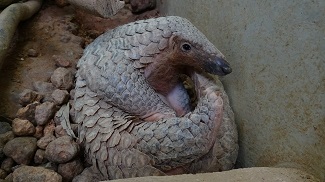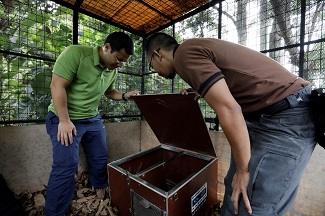Launch of National Conservation Strategy and Action Plan gives boost to Sunda Pangolin conservation in Singapore
18 Sep 2018
Scaly, nocturnal animal a cherished part of Singapore’s natural heritage;
Multi-stakeholder effort to conserve a species of the world’s most widely trafficked mammal


Image 1 (left): Sandshrew the Sunda Pangolin curled up in his den in Night Safari. Rescued in 2017, Sandshrew is the first Sunda Pangolin hand-raised for the purpose of release. His release process is a prime example of the Sunda Pangolin National Conservation Strategy and Action Plan in action and will help to develop future Sunda Pangolin rehabilitation and release protocols.
Image 2 (right) Mr Desmond Lee, Minister for Social and Family Development and Second Minister for National Development and Ade Kurniawan, Life Sciences Associate, Wildlife Reserves Singapore, checking on Sandshrew in his nest box after his journey to his soft release site. The release process for Sandshrew began today with Minister Lee assisting with his transfer to his soft release enclosure.
PHOTO CREDITS: WILDLIFE RESERVES SINGAPORE
In spite of being critically endangered in the region, the Sunda Pangolin (Manis javanica), a species of pangolin, which is the world’s most widely trafficked mammal, has however found a refuge and stronghold in highly urbanised Singapore. Today, with the launch of the Sunda Pangolin National Conservation Strategy and Action Plan at Singapore Zoo by Mr Desmond Lee, Minister for Social and Family Development and Second Minister for National Development, the conservation of this species in Singapore gets a greatly welcomed boost.
For years, wildlife stakeholders and government agencies worldwide have sought to protect the species—an unassuming yet charismatic mammal that sports scales, has no teeth, and curls into a tight ball when it feels threatened. In 2017, 50 conservationists, including some international experts, convened at Singapore Zoo for a workshop to consider the status of the pangolin in Singapore and discuss the way forward for its conservation in the long-term.
Looking ahead towards the next 50 years, the gathering led to a vision and aspirational document—the National Conservation Strategy and Action Plan for Sunda Pangolins in Singapore—to be implemented by the Singapore Pangolin Working Group, which consists of government agencies, non-governmental organisations, tertiary institutions and other individuals. This effort was led by Wildlife Reserves Singapore (WRS) and the National Parks Board (NParks), with support from the IUCN SSC Pangolin Specialist Group, IUCN SSC Asian Species Action Partnership, and IUCN SSC Conservation Planning Specialist Group.
NParks’ Group Director of Conservation, Dr Adrian Loo, said, “In-situ conservation efforts over the years have helped to enhance the ecosystem needed for various native species, including the Sunda Pangolin, to thrive. These efforts include setting aside buffer parks and restoring the habitats in these nature parks, and incorporating culverts to facilitate movement across habitats. In addition, projects like the Eco-Link@BKE have helped to increase the foraging area and connectivity for the species. It is an immediate priority to coordinate and intensify conservation efforts in order to continue to support the conservation of our Sunda Pangolin population. With the launch of the National Conservation Strategy and Action Plan, NParks looks forward to greater collaboration with the various stakeholders to guide the development of long-term conservation and management strategies for this species.”
The vision of the group is: The iconic Sunda Pangolin is a widely-cherished part of Singapore’s natural heritage. Thriving populations live across well-connected natural habitats and urban landscapes, where their needs are sensitively incorporated into Singapore’s development. Coordinated conservation efforts by all stakeholders are successful in eliminating threats, including roadkill, poaching, and trafficking.
To secure a thriving future for the Sunda Pangolin, five goals have been established to pave the way for conservation action:
- To gather and share information on the Sunda Pangolin’s status, ecology, biology and behaviour through ongoing studies and new initiatives.
- To ensure viable populations through habitat protection, restoration, and connectivity.
- To establish wildlife-conscious urban planning policies and measures that protect Sunda Pangolins.
- To develop successful rescue, rehabilitation and release strategies for the Sunda Pangolin and secure the resources to implement them.
- To generate collaborations, clear communication, and awareness across all relevant agencies and solidify a commitment to the conservation of Sunda Pangolins.
Mr Mike Barclay, Group Chief Executive Officer, Mandai Park Holdings said, “In 2009, Night Safari Singapore became the first zoological institution to display the Sunda Pangolin and later to breed the species under human care, but this alone is not enough. To save this iconic animal, we need to work together on a comprehensive and coordinated plan. We are thus optimistic that the National Conservation Strategy and Action Plan will allow pangolins to co-exist with us in our densely populated city.”
Rescue, rehabilitation and release of Sandshrew
A key example of the Sunda Pangolin National Conservation Strategy and Action Plan in action is the rescue and rehabilitation of a baby pangolin for release by the working group. In January 2017, a stranded baby pangolin was rescued and sent to the Wildlife Health and Research Centre in WRS. Nicknamed Sandshrew, it is the first ever case of a baby pangolin being hand-reared and rehabilitated for release. After being under the care of the vets and keepers for almost two years, the release process for Sandshrew began today with Minister Lee assisting in his transfer to the soft release enclosure.
Led by NParks and WRS in a joint operation, the soft release is a lengthy process supported by a team of both staff and volunteers. Sandshrew is first transferred to a soft release enclosure. After it gets used to its surroundings within its soft release enclosure, the gate will be left open for Sandshrew to leave voluntarily. A radio tracking device attached onto one of Sandshrew’s scales will allow its movements in the wild to be monitored. Staff and volunteers will then work in shifts to conduct 24-hour tracking of Sandshrew to ensure that it is coping with life in the wild. Being the first of its kind, the delicate operation could open up opportunities to develop protocols for future rescue and rehabilitation efforts for the species as a whole.
For more information on Sandshrew’s journey, please refer to the Annex.
The Sunda Pangolin National Conservation Strategy and Action Plan can be viewed here.